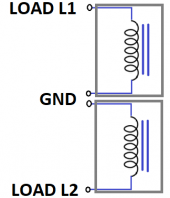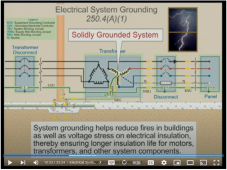I thought of using two transformers because my Grid's utility is 120V-0-208V.
And with that, I cannot use a single center tap transformer (unless I could easily get 120-0-208 transformers).
If my Grid is 120v-0-120v, I will use center tap transformer (as that will provide a stronger grounded system).
Likewise center tap transformers as so easy to get. They are like a dime a dozen.
And since I am not providing Neutral for power, these small ~100W transformers will not get saturated at all.
Nor do I need them perfectly balanced. Even if I use two 240v transformers on my 120v-0-208v line, it will be fine.
But using bigger transformers would give an even stronger grounded system.
At first I thought you meant your utility grid was unbalanced in voltage, L2 was a bit low, 208V to ground.
But do you mean your grid is 120/208Y (L1, L2, L3 are each 120V to N and 120 degrees apart, so L1 is 208V to N)? And you get two out of three phases, L1, L2, N?
In that case the two separate transformers (inductors) are required, which I think you showed. Can't share a core because out of phase (except, some 3-phase transformers do have all three windings on a single "E" core; the way the three fields sum apparently works out.) Maybe two windings on one core (e.g. the secondary windings of 240/480 to 120/240 single-phase transformer) actually works the same, because essentially zero current is being drawn. The fraction of an amp windings will carry are just out of phase. I'll have to ponder that more, maybe SPICE.
"A single Center Tap Transformer (aka AutoTransformer) will work ONLY if the Grid's L1 N L2 are 120V-0-120V and not 120V-0-208V"
If voltages are different from winding ratio, transformer will try to balance the voltage. Voltage of transformer sags due to winding resistance, limiting how hard it tries. A 10% voltage difference would make it try pretty hard, because that is greater than the 3% or 5% "regulation" of the transformer.
If phase is different, it will also try to make current in-phase.
Saturation - I do know a thing or two about that, have been taking measurements driving chokes and inductors into saturation.
Since you are only using a single winding that is around the core on each transformer (your two windings aren't magnetically coupled), let's call them "inductors".
Saturation occurs when magnetization of the core approaches its limit, most magnetic domains have been magnetized. This occurs in proportion to the number of ampere-turns. If there were two windings with current flowing in opposite directions (a transformer), the ampere turns cancel.
When voltage is applied to a winding, V = L di/dt, or I = integral_over_time(V/L).
With 120Vrms 60 Hz applied to a winding designed for that, current rises gradually because "L" remains fairly constant. If frequency was reduced to 30 Hz or voltage increased to 240Vrms, current would approach twice as much and for most transformers it would go into saturation.
Once in saturation, current shoots up to whatever V = IR the winding resistance allows.
If a transformer is designed to carry 100A (and opposite polarity 100A in another winding), it will saturate with less than 1% of that current, something between 0.1A and 1.0A
If you used a 120W 120V transformer for this purpose, 120W / 120V = 1.0A operating current. With just one winding connected and 120V applied, it will carry something on the order of 0.01A
That may keep the two voltages within approximately +/-120V of ground; if they drift, an imbalance in current through the inductor should gently bias them back toward balanced.
Consider what happens if you get a fault between one phase and ground, even high resistance.
N or Ground is zero volts. L1 is tugged gently to zero volts. L2 is now 240Vrms. V = L di/dt, current will ramp up twice as fast. Something beyond half way through an 8 millisecond phase, current will have risen past saturation point, and L2 current will shoot up, clamping L2 voltage to ground.
I think what you are doing is using saturable inductors as voltage clamps.
But does that unceremoniously yank L2 all the way to ground, and afterwards L1 and L2 take turns doing that every phase? Or is it a bit more gradual, and re-centers?
"Even if I use two 240v transformers ..."
That would prevent saturation in this case of L1 getting grounded. It would also reduce the tendency to re-center, because drifting voltage wouldn't go as far into non-linearity.
Transformer inrush is a problem that occurs if a winding is driven with a half-cycle just before power is removed, then when power is reapplied it is driven with a second half-cycle of same polarity. The ampere-turns x time is now double, typically causing saturation.
I think when winding intended for double voltage is used (240V in your case), that is prevented; two successive phases of 120V do not exceed the magnetization of a single 240V phase.








